
Here’s the scenario: you’re travelling in Ho Chi Minh and you’ve made it your mission to buy fish sauce. There is no Red Boat in the supermarkets here, no English-friendly labelling anywhere. You have no internet on your phone because you’re travelling cheap, you forgot to look up the brands your Vietnamese friends recommended, and anyway this is your last day in Vietnam and you have no more time to waste. Neither you nor your travel buddy speaks Vietnamese, your only local friend in the city is at work, and nobody in the store speaks enough English (or Mandarin Chinese, Cantonese, Japanese, or Serahule in our case) to explain what you're getting. You need to figure out how to choose a bottle of fish sauce from the shelves in front of you, and fast. Dear traveler, this is the guide for you.
The extent of my Vietnamese runs to saying, “Hello, I am Flory, fish sauce, thank you,” oddly fluently, which should give you a good indication of my priorities in language acquisition. I don’t speak Vietnamese, full stop. I’m far from being an expert in Vietnamese food. But armed with some fore-knowledge of what to look for, I recently made it back home to Japan with three bottles of pretty darn delicious fish sauce. Even if you can’t learn a language in two weeks, you can at least buy fish sauce in a supermarket.
A Non-Viet Speaker’s Guide to Finding Fish Sauce in the Supermarket in Vietnam
#1 Words to know
#2 Protein content
#3 Does it say ‘Phu Quoc’?
#4 Price
#5 Bringing it home
#6 Okay, here are some brands
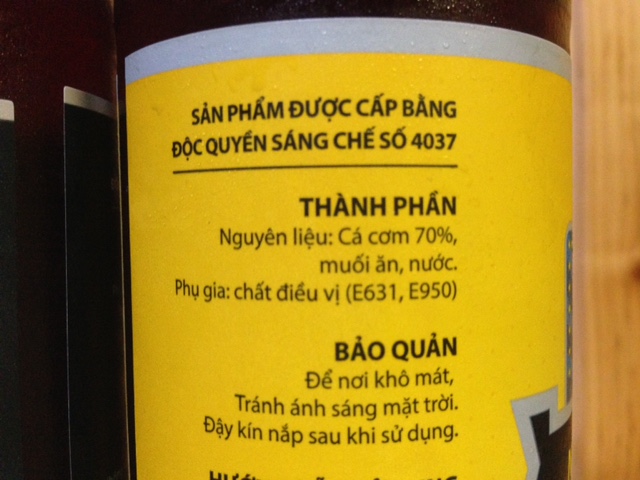 #1 Words to know
#1 Words to know
This is your essential bare-bones vocabulary list in order of most important to least:
nước mắm (nuh-k mah-m): fish sauce. This will guide you to the aisle where the fish sauce is -- usually there's a whole aisle dedicated to it. Or you can ask a supermarket staff member to point you there! “
Chao anh…nước mắm?"
cá cơm: anchovy. According to Andrea Nguyen, doyenne of Vietnamese cooking in America,
ca com probably indicates that the fish sauce was made with a higher-quality anchovy found in the waters around Phu Quoc Island. That’s good enough for me!
muối: salt.
nước: water or liquid. Some brands have added water to dilute the fish sauce, usually the weaker ones, or lower quality ones.
These four words are the truly essential words that should stay in your head. If the ingredient list only has
cá cơm and
muối, you’ve hit the jackpot!
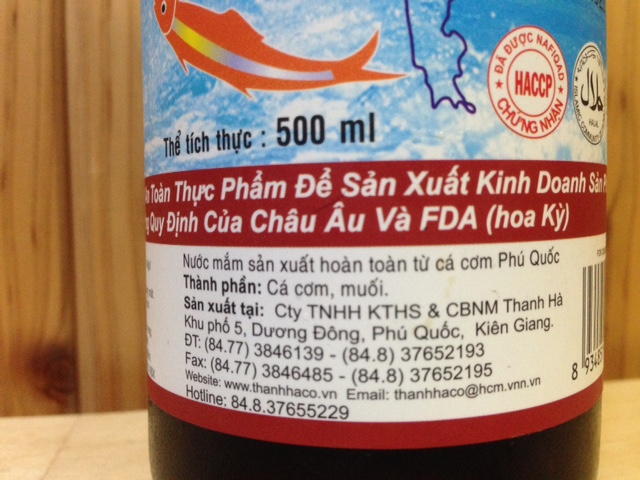 thành phần
thành phần:
ingredients. Strictly speaking, if you can find ‘
ca com’ and ‘
muoi’ in succession you won’t need to remember this.
nguyên liệu: raw materials. This phrase occasionally turns up, e.g. on the Hanh Phuc bottles of fish sauce.
nhĩ: first press. Most bottles of fish sauce I saw didn’t have this word, but if they do, hey, JACKPOT. I mean, they could be lying (#nonvietspeaker) but it’s not a bad indicator either.
đường: sugar. Some inferior fish sauces, or Thai styles of fish sauce, use sugar in their product. Chin-su brand is a good example.
phụ gia: additives. An example of what you shouldn’t be seeing on the label.
chất điều vị: flavour enhancers. The meaning of this phrase is pretty easy to guess when it’s followed by a bunch of E numbers. (Side note: I keep reading this in my head in a French accent)
Basically, the fewer ingredients on the label, the better.
#2 Nitrogen content
What you’re looking for is a number - it’ll look like any of the following: --°N, --N, --°, --do dam, --dam, like in this photo.
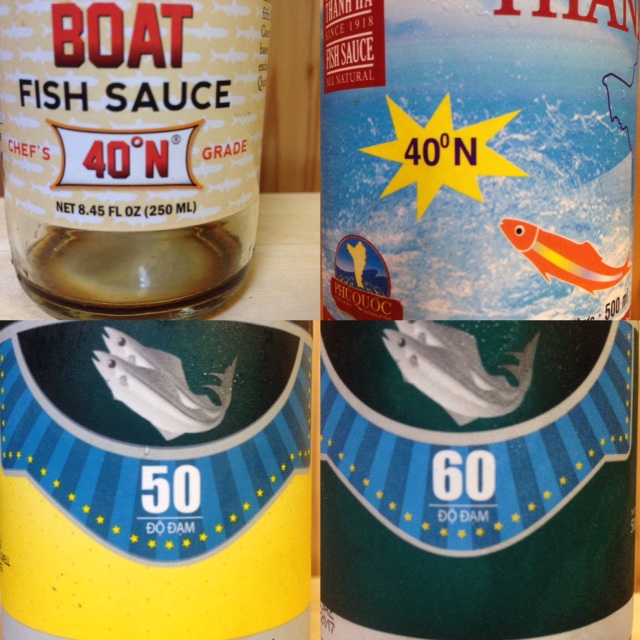
These are all ways indicating grams of nitrogen per litre of fish sauce -- so the higher the number, in general, the higher the protein level in your sauce, and the stronger-tasting and more complex your fish sauce.
Lower numbered fish sauces -- around 20N-25N -- are usually diluted with water and other additives. 30N-35N are good for everyday cooking. 40N and above is where you start getting into smack-your-tongue-with-a-fish territory. The highest available is around 50-60N. Depending on the fish sauce itself, you’ll probably be wanting to use higher-N sauces for dipping, dressing and other applications where it can really shine.
#3 Does it say ‘Phú Quốc’?
Phú Quốc Island is where the best fish sauce is produced (supposedly), and the waters around the island are where the best anchovies can be found. Not every fish sauce labeled ‘Phú Quốc’ is necessarily made on the island itself -- call it aspirational labelling, bandwagon-hopping, whatever -- so I personally would not buy a fish sauce based solely on this. Although it’s a pretty good start to trying to pick one.
#4 Price
Price is a fairly good indicator of what’s good, or at least better than average. The lowest quality fish sauces were packaged in plastic bottles and much cheaper than their glass bottle counterparts. Fish sauces with higher N-numbers were more expensive, sometimes significantly so, than those with lower numbers. Good packaging, while not the deciding factor, definitely helps in selecting fish sauce when you can’t read anything in front of you.
#5 Bring Your Bounty Home
I don’t live in the U.S., so I don’t know how customs will react to fish sauce in your suitcase, but I’ve never had any trouble with bringing fish sauce into Japan. I’ve also not had a problem with bringing Red Boat fish sauce out of the U.S. Each time, though, I’ve made sure to pack each (glass) bottle very securely. This means an initial layer of newspaper. Then a plastic bag wrap. And another plastic bag wrap. Possibly a third for good measure, and then padded by bags of Vietnamese coffee on each side and clothes.
Ideally you would be transporting fish sauce upright, but that’s a no-go for flights home, so take the extra precautions. When I unpacked my suitcase, it turned out one of the bottles had sprung a slight leak, which had been ameliorated by the extra plastic bags wrapping it. Disaster averted!
#6 Some Fish Sauce Brands, or I Bet You Skipped Right To This Section ;)
Every
Vinamart or mom-and-pop shop I walked into in Saigon (and believe me, my travel buddy and I walked into MANY) didn’t have much variety in the fish sauces or they only had lower-quality sauces like Chin-su on their shelves, so I’m going to go ahead and recommend that you find a big
Co-op supermarket. All the brands below (with the exception of Ong Ky, as far as I can tell) can be found at
Co-op. There are probably other big supermarkets there, so if you're in the country, check them out and see what they stock!
Chin-su: This is one of the lower-end fish sauce brands, and one you’ll see in the kitchens of many cheap restaurants/vendors all over Saigon. According to the link, the Chin-su Nam Ngu sauce is a 'premium' sauce but it sure doesn't taste like one. It tastes pretty MSG-y and doctored up -- hello E-numbers! -- but it’s fine for most high-heat cooking or splashing into your braises, especially if you’re on a budget. I wouldn’t use it for dipping sauces.
Ong Ky: I’ve never tried this, and I didn’t see this at the Coop supermarkets I went to, but a Viet friend says this is one of the better brands on the market. Check the ingredient list before buying.
Thuan Phat: This was the brand I bought on a 2013 visit to Hanoi when I didn’t know anything except to look for ‘Phu Quoc.’ At the time, it was light years ahead of any fish sauce I’d tasted before, way better than Squid or Three Crabs, and I enjoyed using it a lot. This time around in Saigon, I noticed a long list of additives after salt and anchovy so I left it alone. You’ll probably be alright if this is all you can find -- it's way better than Squid.
Hanh Phuc One of the few fish sauces sold in Vietnam to have an ingredient list in English.
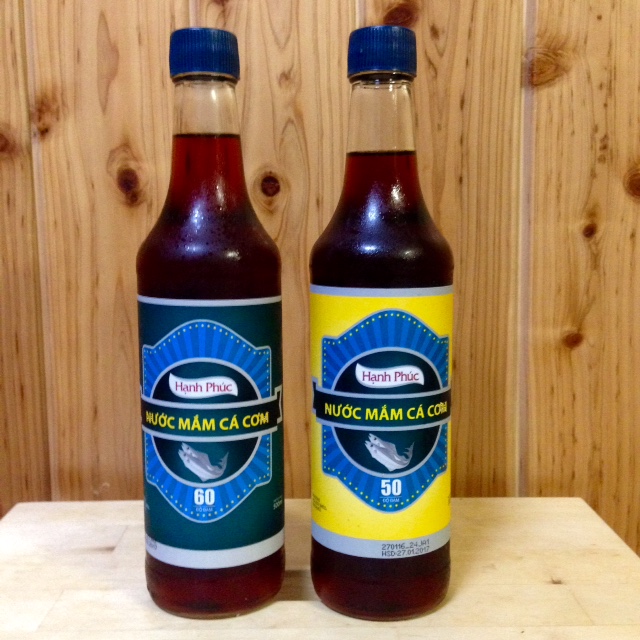
This is a lesson in cross-checking ingredient lists in both languages though, because in Vietnam, a couple of E-number additives are listed whereas they are not in English, and I only realised this after coming home.
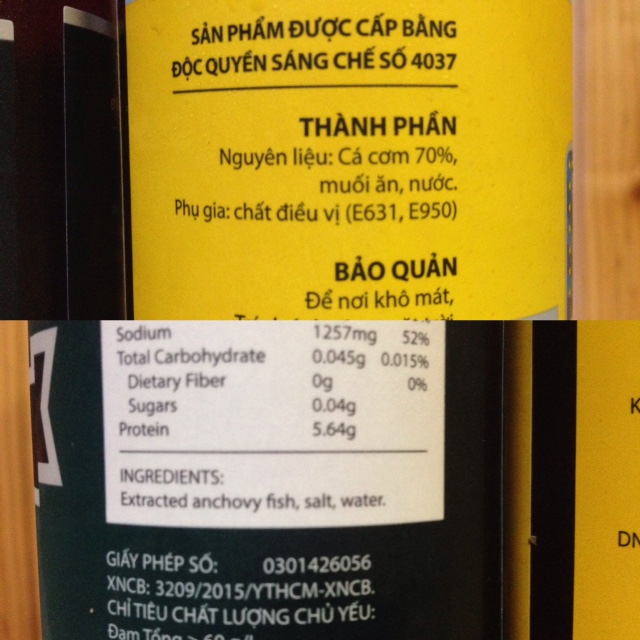
It’s available in 50N and 60N bottles. 50N is oddly enough a little more aggressively salty than its 60N counterpart, which has a more concentrated anchovy flavour as it should. Both smell more noticeably fishy, with a slight harsh edge to its scent. I also detected a faint metallic aftertaste, but that might just be me. Since both are much stronger and saltier fish sauces, I would be careful when adding them to dishes, as they can be pretty overpowering. 60N would make a lovely
nuoc cham, diluted with a little water.
Overall, though, recommended! I can’t wait to cook with them.
Thanh Ha: Nuoc Mam Nhi Chanh Hieu Phu Quoc: This one ticks all the goddamn boxes.
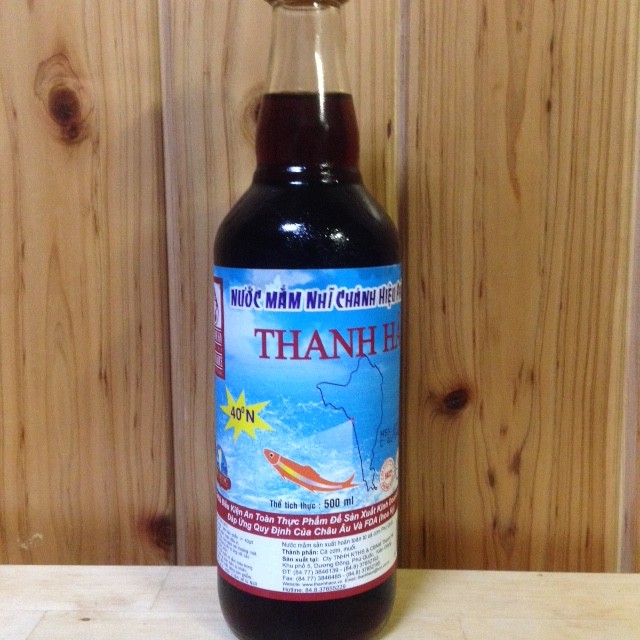
Ingredient list: only anchovies and salt? Check! First press? Check! 40 N, made in Phu Quoc? Bam! It’s got a map outline, a ‘Phu Quoc’ seal and a cute little cartoon anchovy on the label. It’s even halal-certified if you’re inclined that way.
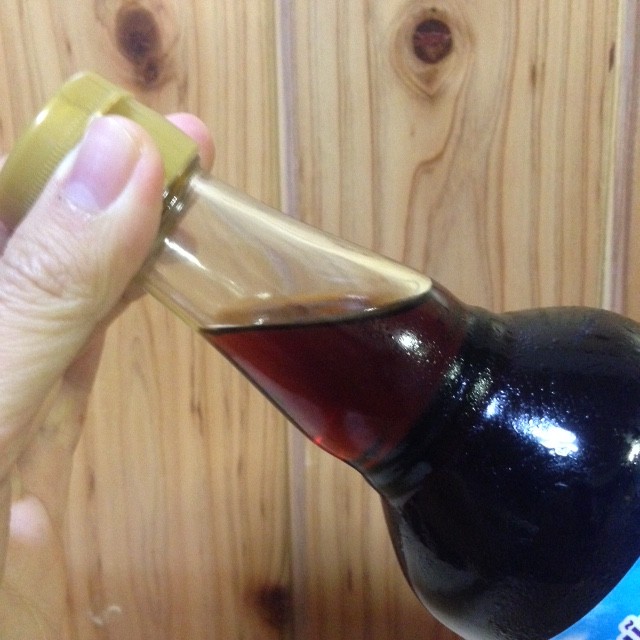
Now for the fish sauce itself: salty, fishy, and deeply savoury, with a sweet finish. When I opened the bottle I wanted to drink in the scent for hours, and it’s just struck me:
it fucking smells like Parma ham, which is my favourite cured meat ever. That is pure umami assaulting your nose, the kind of umami which can only come from hanging around in a barrel for months on end. It totally knocks my Hanh Phuc sauces out of the waters. I find that the 40N Red Boat tastes a little too salty right next to this -- RB is very good, but distinctly heavier and saltier. If it was a matter of life or death I would throw the Red Boat bottle away and run screaming for the hills, clutching my precious bottle of Tranh Ha fish sauce.
In short, Thanh Ha is my new favourite fish sauce, and I’m already wishing I’d gotten a second bottle -- it’s the best 60,700VND (around $3) I’ve ever spent. Oh well -- I loved Saigon and I’m committed to a return visit at some point in the next few years… preferably with a little more Vietnamese under my belt.
Other guides to fish sauce for U.S.-based readers:
How to Buy Fish Sauce: A guide
Premium Fish Sauces to Try: Red Boat, IHA, Megachef
Fish Sauce Taste Test, 13 Brands Compared (the comments are #popcorn)
 Here’s the scenario: you’re travelling in Ho Chi Minh and you’ve made it your mission to buy fish sauce. There is no Red Boat in the supermarkets here, no English-friendly labelling anywhere. You have no internet on your phone because you’re travelling cheap, you forgot to look up the brands your Vietnamese friends recommended, and anyway this is your last day in Vietnam and you have no more time to waste. Neither you nor your travel buddy speaks Vietnamese, your only local friend in the city is at work, and nobody in the store speaks enough English (or Mandarin Chinese, Cantonese, Japanese, or Serahule in our case) to explain what you're getting. You need to figure out how to choose a bottle of fish sauce from the shelves in front of you, and fast. Dear traveler, this is the guide for you.
The extent of my Vietnamese runs to saying, “Hello, I am Flory, fish sauce, thank you,” oddly fluently, which should give you a good indication of my priorities in language acquisition. I don’t speak Vietnamese, full stop. I’m far from being an expert in Vietnamese food. But armed with some fore-knowledge of what to look for, I recently made it back home to Japan with three bottles of pretty darn delicious fish sauce. Even if you can’t learn a language in two weeks, you can at least buy fish sauce in a supermarket.
A Non-Viet Speaker’s Guide to Finding Fish Sauce in the Supermarket in Vietnam
#1 Words to know
#2 Protein content
#3 Does it say ‘Phu Quoc’?
#4 Price
#5 Bringing it home
#6 Okay, here are some brands
Here’s the scenario: you’re travelling in Ho Chi Minh and you’ve made it your mission to buy fish sauce. There is no Red Boat in the supermarkets here, no English-friendly labelling anywhere. You have no internet on your phone because you’re travelling cheap, you forgot to look up the brands your Vietnamese friends recommended, and anyway this is your last day in Vietnam and you have no more time to waste. Neither you nor your travel buddy speaks Vietnamese, your only local friend in the city is at work, and nobody in the store speaks enough English (or Mandarin Chinese, Cantonese, Japanese, or Serahule in our case) to explain what you're getting. You need to figure out how to choose a bottle of fish sauce from the shelves in front of you, and fast. Dear traveler, this is the guide for you.
The extent of my Vietnamese runs to saying, “Hello, I am Flory, fish sauce, thank you,” oddly fluently, which should give you a good indication of my priorities in language acquisition. I don’t speak Vietnamese, full stop. I’m far from being an expert in Vietnamese food. But armed with some fore-knowledge of what to look for, I recently made it back home to Japan with three bottles of pretty darn delicious fish sauce. Even if you can’t learn a language in two weeks, you can at least buy fish sauce in a supermarket.
A Non-Viet Speaker’s Guide to Finding Fish Sauce in the Supermarket in Vietnam
#1 Words to know
#2 Protein content
#3 Does it say ‘Phu Quoc’?
#4 Price
#5 Bringing it home
#6 Okay, here are some brands
 #1 Words to know
This is your essential bare-bones vocabulary list in order of most important to least:
nước mắm (nuh-k mah-m): fish sauce. This will guide you to the aisle where the fish sauce is -- usually there's a whole aisle dedicated to it. Or you can ask a supermarket staff member to point you there! “Chao anh…nước mắm?"
cá cơm: anchovy. According to Andrea Nguyen, doyenne of Vietnamese cooking in America, ca com probably indicates that the fish sauce was made with a higher-quality anchovy found in the waters around Phu Quoc Island. That’s good enough for me!
muối: salt.
nước: water or liquid. Some brands have added water to dilute the fish sauce, usually the weaker ones, or lower quality ones.
These four words are the truly essential words that should stay in your head. If the ingredient list only has cá cơm and muối, you’ve hit the jackpot!
#1 Words to know
This is your essential bare-bones vocabulary list in order of most important to least:
nước mắm (nuh-k mah-m): fish sauce. This will guide you to the aisle where the fish sauce is -- usually there's a whole aisle dedicated to it. Or you can ask a supermarket staff member to point you there! “Chao anh…nước mắm?"
cá cơm: anchovy. According to Andrea Nguyen, doyenne of Vietnamese cooking in America, ca com probably indicates that the fish sauce was made with a higher-quality anchovy found in the waters around Phu Quoc Island. That’s good enough for me!
muối: salt.
nước: water or liquid. Some brands have added water to dilute the fish sauce, usually the weaker ones, or lower quality ones.
These four words are the truly essential words that should stay in your head. If the ingredient list only has cá cơm and muối, you’ve hit the jackpot!
 thành phần: ingredients. Strictly speaking, if you can find ‘ca com’ and ‘muoi’ in succession you won’t need to remember this.
nguyên liệu: raw materials. This phrase occasionally turns up, e.g. on the Hanh Phuc bottles of fish sauce.
nhĩ: first press. Most bottles of fish sauce I saw didn’t have this word, but if they do, hey, JACKPOT. I mean, they could be lying (#nonvietspeaker) but it’s not a bad indicator either.
đường: sugar. Some inferior fish sauces, or Thai styles of fish sauce, use sugar in their product. Chin-su brand is a good example.
phụ gia: additives. An example of what you shouldn’t be seeing on the label.
chất điều vị: flavour enhancers. The meaning of this phrase is pretty easy to guess when it’s followed by a bunch of E numbers. (Side note: I keep reading this in my head in a French accent)
Basically, the fewer ingredients on the label, the better.
#2 Nitrogen content
What you’re looking for is a number - it’ll look like any of the following: --°N, --N, --°, --do dam, --dam, like in this photo.
thành phần: ingredients. Strictly speaking, if you can find ‘ca com’ and ‘muoi’ in succession you won’t need to remember this.
nguyên liệu: raw materials. This phrase occasionally turns up, e.g. on the Hanh Phuc bottles of fish sauce.
nhĩ: first press. Most bottles of fish sauce I saw didn’t have this word, but if they do, hey, JACKPOT. I mean, they could be lying (#nonvietspeaker) but it’s not a bad indicator either.
đường: sugar. Some inferior fish sauces, or Thai styles of fish sauce, use sugar in their product. Chin-su brand is a good example.
phụ gia: additives. An example of what you shouldn’t be seeing on the label.
chất điều vị: flavour enhancers. The meaning of this phrase is pretty easy to guess when it’s followed by a bunch of E numbers. (Side note: I keep reading this in my head in a French accent)
Basically, the fewer ingredients on the label, the better.
#2 Nitrogen content
What you’re looking for is a number - it’ll look like any of the following: --°N, --N, --°, --do dam, --dam, like in this photo.
 These are all ways indicating grams of nitrogen per litre of fish sauce -- so the higher the number, in general, the higher the protein level in your sauce, and the stronger-tasting and more complex your fish sauce.
Lower numbered fish sauces -- around 20N-25N -- are usually diluted with water and other additives. 30N-35N are good for everyday cooking. 40N and above is where you start getting into smack-your-tongue-with-a-fish territory. The highest available is around 50-60N. Depending on the fish sauce itself, you’ll probably be wanting to use higher-N sauces for dipping, dressing and other applications where it can really shine.
#3 Does it say ‘Phú Quốc’?
Phú Quốc Island is where the best fish sauce is produced (supposedly), and the waters around the island are where the best anchovies can be found. Not every fish sauce labeled ‘Phú Quốc’ is necessarily made on the island itself -- call it aspirational labelling, bandwagon-hopping, whatever -- so I personally would not buy a fish sauce based solely on this. Although it’s a pretty good start to trying to pick one.
#4 Price
Price is a fairly good indicator of what’s good, or at least better than average. The lowest quality fish sauces were packaged in plastic bottles and much cheaper than their glass bottle counterparts. Fish sauces with higher N-numbers were more expensive, sometimes significantly so, than those with lower numbers. Good packaging, while not the deciding factor, definitely helps in selecting fish sauce when you can’t read anything in front of you.
#5 Bring Your Bounty Home
I don’t live in the U.S., so I don’t know how customs will react to fish sauce in your suitcase, but I’ve never had any trouble with bringing fish sauce into Japan. I’ve also not had a problem with bringing Red Boat fish sauce out of the U.S. Each time, though, I’ve made sure to pack each (glass) bottle very securely. This means an initial layer of newspaper. Then a plastic bag wrap. And another plastic bag wrap. Possibly a third for good measure, and then padded by bags of Vietnamese coffee on each side and clothes.
Ideally you would be transporting fish sauce upright, but that’s a no-go for flights home, so take the extra precautions. When I unpacked my suitcase, it turned out one of the bottles had sprung a slight leak, which had been ameliorated by the extra plastic bags wrapping it. Disaster averted!
#6 Some Fish Sauce Brands, or I Bet You Skipped Right To This Section ;)
Every Vinamart or mom-and-pop shop I walked into in Saigon (and believe me, my travel buddy and I walked into MANY) didn’t have much variety in the fish sauces or they only had lower-quality sauces like Chin-su on their shelves, so I’m going to go ahead and recommend that you find a big Co-op supermarket. All the brands below (with the exception of Ong Ky, as far as I can tell) can be found at Co-op. There are probably other big supermarkets there, so if you're in the country, check them out and see what they stock!
Chin-su: This is one of the lower-end fish sauce brands, and one you’ll see in the kitchens of many cheap restaurants/vendors all over Saigon. According to the link, the Chin-su Nam Ngu sauce is a 'premium' sauce but it sure doesn't taste like one. It tastes pretty MSG-y and doctored up -- hello E-numbers! -- but it’s fine for most high-heat cooking or splashing into your braises, especially if you’re on a budget. I wouldn’t use it for dipping sauces.
Ong Ky: I’ve never tried this, and I didn’t see this at the Coop supermarkets I went to, but a Viet friend says this is one of the better brands on the market. Check the ingredient list before buying.
Thuan Phat: This was the brand I bought on a 2013 visit to Hanoi when I didn’t know anything except to look for ‘Phu Quoc.’ At the time, it was light years ahead of any fish sauce I’d tasted before, way better than Squid or Three Crabs, and I enjoyed using it a lot. This time around in Saigon, I noticed a long list of additives after salt and anchovy so I left it alone. You’ll probably be alright if this is all you can find -- it's way better than Squid.
Hanh Phuc One of the few fish sauces sold in Vietnam to have an ingredient list in English.
These are all ways indicating grams of nitrogen per litre of fish sauce -- so the higher the number, in general, the higher the protein level in your sauce, and the stronger-tasting and more complex your fish sauce.
Lower numbered fish sauces -- around 20N-25N -- are usually diluted with water and other additives. 30N-35N are good for everyday cooking. 40N and above is where you start getting into smack-your-tongue-with-a-fish territory. The highest available is around 50-60N. Depending on the fish sauce itself, you’ll probably be wanting to use higher-N sauces for dipping, dressing and other applications where it can really shine.
#3 Does it say ‘Phú Quốc’?
Phú Quốc Island is where the best fish sauce is produced (supposedly), and the waters around the island are where the best anchovies can be found. Not every fish sauce labeled ‘Phú Quốc’ is necessarily made on the island itself -- call it aspirational labelling, bandwagon-hopping, whatever -- so I personally would not buy a fish sauce based solely on this. Although it’s a pretty good start to trying to pick one.
#4 Price
Price is a fairly good indicator of what’s good, or at least better than average. The lowest quality fish sauces were packaged in plastic bottles and much cheaper than their glass bottle counterparts. Fish sauces with higher N-numbers were more expensive, sometimes significantly so, than those with lower numbers. Good packaging, while not the deciding factor, definitely helps in selecting fish sauce when you can’t read anything in front of you.
#5 Bring Your Bounty Home
I don’t live in the U.S., so I don’t know how customs will react to fish sauce in your suitcase, but I’ve never had any trouble with bringing fish sauce into Japan. I’ve also not had a problem with bringing Red Boat fish sauce out of the U.S. Each time, though, I’ve made sure to pack each (glass) bottle very securely. This means an initial layer of newspaper. Then a plastic bag wrap. And another plastic bag wrap. Possibly a third for good measure, and then padded by bags of Vietnamese coffee on each side and clothes.
Ideally you would be transporting fish sauce upright, but that’s a no-go for flights home, so take the extra precautions. When I unpacked my suitcase, it turned out one of the bottles had sprung a slight leak, which had been ameliorated by the extra plastic bags wrapping it. Disaster averted!
#6 Some Fish Sauce Brands, or I Bet You Skipped Right To This Section ;)
Every Vinamart or mom-and-pop shop I walked into in Saigon (and believe me, my travel buddy and I walked into MANY) didn’t have much variety in the fish sauces or they only had lower-quality sauces like Chin-su on their shelves, so I’m going to go ahead and recommend that you find a big Co-op supermarket. All the brands below (with the exception of Ong Ky, as far as I can tell) can be found at Co-op. There are probably other big supermarkets there, so if you're in the country, check them out and see what they stock!
Chin-su: This is one of the lower-end fish sauce brands, and one you’ll see in the kitchens of many cheap restaurants/vendors all over Saigon. According to the link, the Chin-su Nam Ngu sauce is a 'premium' sauce but it sure doesn't taste like one. It tastes pretty MSG-y and doctored up -- hello E-numbers! -- but it’s fine for most high-heat cooking or splashing into your braises, especially if you’re on a budget. I wouldn’t use it for dipping sauces.
Ong Ky: I’ve never tried this, and I didn’t see this at the Coop supermarkets I went to, but a Viet friend says this is one of the better brands on the market. Check the ingredient list before buying.
Thuan Phat: This was the brand I bought on a 2013 visit to Hanoi when I didn’t know anything except to look for ‘Phu Quoc.’ At the time, it was light years ahead of any fish sauce I’d tasted before, way better than Squid or Three Crabs, and I enjoyed using it a lot. This time around in Saigon, I noticed a long list of additives after salt and anchovy so I left it alone. You’ll probably be alright if this is all you can find -- it's way better than Squid.
Hanh Phuc One of the few fish sauces sold in Vietnam to have an ingredient list in English.
 This is a lesson in cross-checking ingredient lists in both languages though, because in Vietnam, a couple of E-number additives are listed whereas they are not in English, and I only realised this after coming home.
This is a lesson in cross-checking ingredient lists in both languages though, because in Vietnam, a couple of E-number additives are listed whereas they are not in English, and I only realised this after coming home.
 It’s available in 50N and 60N bottles. 50N is oddly enough a little more aggressively salty than its 60N counterpart, which has a more concentrated anchovy flavour as it should. Both smell more noticeably fishy, with a slight harsh edge to its scent. I also detected a faint metallic aftertaste, but that might just be me. Since both are much stronger and saltier fish sauces, I would be careful when adding them to dishes, as they can be pretty overpowering. 60N would make a lovely nuoc cham, diluted with a little water.
Overall, though, recommended! I can’t wait to cook with them.
Thanh Ha: Nuoc Mam Nhi Chanh Hieu Phu Quoc: This one ticks all the goddamn boxes.
It’s available in 50N and 60N bottles. 50N is oddly enough a little more aggressively salty than its 60N counterpart, which has a more concentrated anchovy flavour as it should. Both smell more noticeably fishy, with a slight harsh edge to its scent. I also detected a faint metallic aftertaste, but that might just be me. Since both are much stronger and saltier fish sauces, I would be careful when adding them to dishes, as they can be pretty overpowering. 60N would make a lovely nuoc cham, diluted with a little water.
Overall, though, recommended! I can’t wait to cook with them.
Thanh Ha: Nuoc Mam Nhi Chanh Hieu Phu Quoc: This one ticks all the goddamn boxes.
 Ingredient list: only anchovies and salt? Check! First press? Check! 40 N, made in Phu Quoc? Bam! It’s got a map outline, a ‘Phu Quoc’ seal and a cute little cartoon anchovy on the label. It’s even halal-certified if you’re inclined that way.
Ingredient list: only anchovies and salt? Check! First press? Check! 40 N, made in Phu Quoc? Bam! It’s got a map outline, a ‘Phu Quoc’ seal and a cute little cartoon anchovy on the label. It’s even halal-certified if you’re inclined that way.
 Now for the fish sauce itself: salty, fishy, and deeply savoury, with a sweet finish. When I opened the bottle I wanted to drink in the scent for hours, and it’s just struck me: it fucking smells like Parma ham, which is my favourite cured meat ever. That is pure umami assaulting your nose, the kind of umami which can only come from hanging around in a barrel for months on end. It totally knocks my Hanh Phuc sauces out of the waters. I find that the 40N Red Boat tastes a little too salty right next to this -- RB is very good, but distinctly heavier and saltier. If it was a matter of life or death I would throw the Red Boat bottle away and run screaming for the hills, clutching my precious bottle of Tranh Ha fish sauce.
In short, Thanh Ha is my new favourite fish sauce, and I’m already wishing I’d gotten a second bottle -- it’s the best 60,700VND (around $3) I’ve ever spent. Oh well -- I loved Saigon and I’m committed to a return visit at some point in the next few years… preferably with a little more Vietnamese under my belt.
Other guides to fish sauce for U.S.-based readers:
How to Buy Fish Sauce: A guide
Premium Fish Sauces to Try: Red Boat, IHA, Megachef
Fish Sauce Taste Test, 13 Brands Compared (the comments are #popcorn)
Now for the fish sauce itself: salty, fishy, and deeply savoury, with a sweet finish. When I opened the bottle I wanted to drink in the scent for hours, and it’s just struck me: it fucking smells like Parma ham, which is my favourite cured meat ever. That is pure umami assaulting your nose, the kind of umami which can only come from hanging around in a barrel for months on end. It totally knocks my Hanh Phuc sauces out of the waters. I find that the 40N Red Boat tastes a little too salty right next to this -- RB is very good, but distinctly heavier and saltier. If it was a matter of life or death I would throw the Red Boat bottle away and run screaming for the hills, clutching my precious bottle of Tranh Ha fish sauce.
In short, Thanh Ha is my new favourite fish sauce, and I’m already wishing I’d gotten a second bottle -- it’s the best 60,700VND (around $3) I’ve ever spent. Oh well -- I loved Saigon and I’m committed to a return visit at some point in the next few years… preferably with a little more Vietnamese under my belt.
Other guides to fish sauce for U.S.-based readers:
How to Buy Fish Sauce: A guide
Premium Fish Sauces to Try: Red Boat, IHA, Megachef
Fish Sauce Taste Test, 13 Brands Compared (the comments are #popcorn)

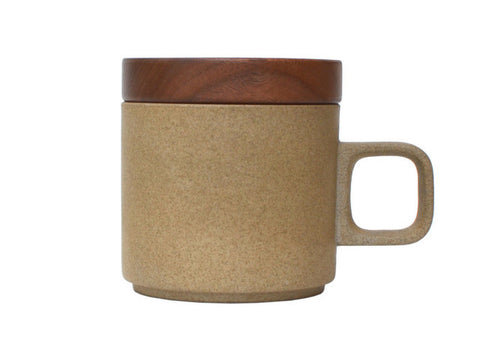


Comments (2)
Have you tasted MegachefFish Sauce? Now this is what fish sauce should taste like :)
For your information, “Nam Ngu”, Chinsu’s so called “High end” fish sauce is no fish sauce at all. Information found on its label (Under strong magnification, as they are tiny in print) show the product name “Nước Chấm” (Sauce) and not “Nước Mắm” (Fish sauce. A very cunning trick on Vietnamese comsumers!